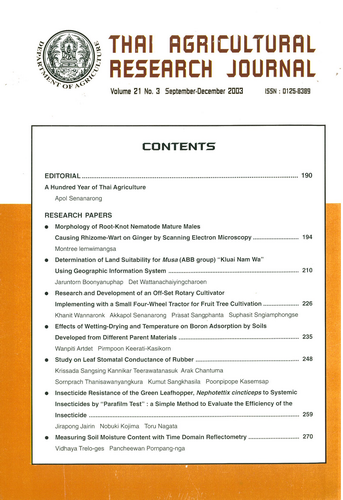Effects of Wetting-Drying and Temperature on Boron Adsorption by Soils Developed from Different Parent Mataerials
DOI:
https://doi.org/10.14456/thaidoa-agres.2003.18Keywords:
boron adsorption; wetting and drying; temperature; parent material; residual; alluvialAbstract
Objectives of this study were to determine the effects of wetting-drying an temperature on boron adsorption by soils from different parent materials. Soil samples containing boron were subjected to 0, 1 and 5 wetting-drying cycles at 25๐C and 40๐C. Two boron concentration used were 0.02 mg B/I and 0.10 mg B/I. Interaction effects of wetting-drying and temperature and soil series on boron adsorption were found. Increasing wetting-drying from 1 to 5 cycles decreased soil boron adsorption to 13 and 16% at 25 ๐C and 40๐C respectively; whereas increasing temperature from 25๐C to 40๐C decreased boron
adsorption of soil treated with 1 and 5 wetting-drying cycles to 3 and 6% respectively. However, increasing wetting-drying from 0 to 1 cycle at 25๐C increased boron adsorption (no 0 cycle treatment at 40๐C). Increasing wetting-drying from 1 to 5 cycles decreased boron adsorption by alluvial and residual soils to 11 and 15% at 25๐C, 8% and 22% at 40 ๐C respectively, by surface and subsoil to 11 and 14% at 25๐C, 8% at 25๐C and both 16% at 40๐C respectively. However, increasing wetting-drying from 0 to 1 cycle (at 25๐C) increased boron adsorption by alluvial and residual soils to 14 and 29%, by surface and subsoil to 20 and 24% respectively. A stronger effect was found on the wetting and drying factor than the temperature. Soil developed from residuum adsorbed more boron than the one developed from alluvium. The subsoil adsorbed more boron than the surface one.
Downloads
Published
How to Cite
Issue
Section
License

This work is licensed under a Creative Commons Attribution-NonCommercial-NoDerivatives 4.0 International License.
Thai Agricultural Research Journal



